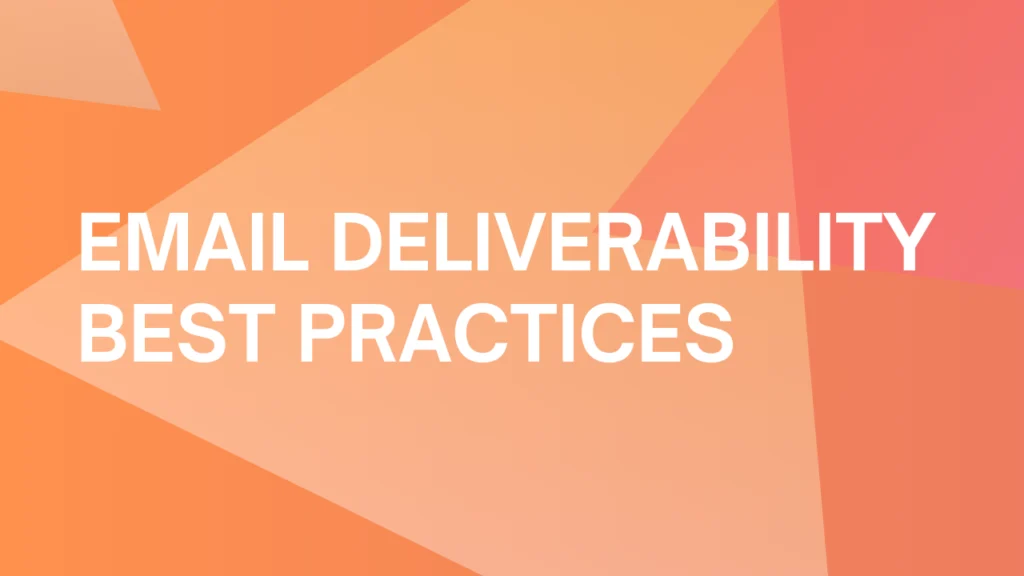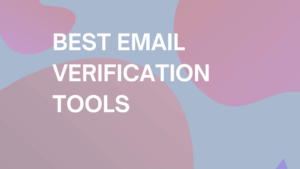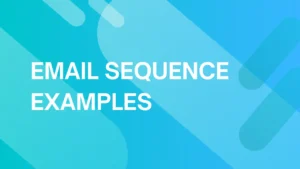
5 email deliverability best practices you need to master
Composing a great email is tough enough, but that’s only half the battle for your prospects’ time and attention.
You also need to make sure it’s delivered.
There’s more to this than many marketers realize — it isn’t merely a case of getting addresses right.
In fact, according to 2022 research by Email Tool Tester, just 81% of emails arrive at their intended inboxes. That’s almost a fifth caught by spam filters, mistaken data entry or further blocks to getting your message seen and keenly appreciated.
When we dig into the truth of email deliverability challenges, there’s a lot to consider for your next nurturing cycle. From your email content and subscription options to the sender reputation that may place you on a blacklist unawares, it’s a matter of what you include within each message, as well as the trust you’re able to build online.
Piece by piece, you can make changes to deliverability practices, helping a marketing strategy go further with the same resources.
Join us for a rundown of five problems and fixes that will improve your email hit rate.
1. Avoid spam email triggers
Every email provider wants to shut out as many malicious or misleading messages as possible.
Sometimes, that means you’re unfairly penalized. Marketers who use certain language, symbols, punctuation and additional material can fall into the spam folder.
You won’t know it until engagement rates remain dead for those contacts and your sender reputation starts to suffer (more on that later).
Some content is quite obviously related to spam; other choices are more subtle. You just have to be aware of whether every line, sentence or visual quirk might trigger the spam trap.
We can break down several themes for high-risk emails:
- Urgent, salesy language: A spam filter will likely pick up on any requests for the recipient to do something right away, especially if you mention a limited-time deal or flash sale.
- Fast earnings and free offers: Spammers tend to stuff an email and subject line with promises of earning money. Drawing attention to this makes your message suspicious. Similarly, constantly referring to free services, packages or giveaways will do you more harm than good.
- Seasons and days of the week: It’s another plea for urgency. When you’re crafting messages for Christmas, a summer bank holiday, Black Friday, the Easter weekend or any seasonal period, it’s worth sticking to one or two mentions at most. If you can, avoid including days of the week altogether.
- Overblown adjectives: A spam email is more prone to using superlative language to convince people to make a rapid decision they might regret. So stay on guard for hyping your products or services up too much.
What do these danger zones look like in practice? While an email service provider will have their own spam triggers, here are some examples of words and phrases that crop up across the board:
- “Last chance.”
- “Final deal.”
- “Clearance sale.”
- “Buy direct.”
- “Earn cash.”
- “Work from home.”
- “Bargain.”
- “Cut price.”
- “Ultimate.”
- “Stupendous.”
- “Best ever.”
- “Terrific.”
- “Buy now.”
- “Act fast.”
- “Don’t wait.”
- “Money back.”
- “Lowest price.”
- “Lifetime.”
- “Satisfaction.”
Excessive emojis and punctuation — particularly in a subject line — aren’t useful either. Typing !! or $$$ isn’t going to make your message more captivating, but it could label you as spam.
That’s true of all caps as well. Keep grammar and punctuation professional in a readable font that follows the rules of good English.
You can also be flagged as spam for including attachments (PDFs, slide decks, video files, etc.), so leave additional media to links you’ll place in the body copy.
And while you’re at it, don’t use a link shortener! Spammers like to hide nefarious websites in mini URLs. Just paste the full link or use a hyperlink in your CTA buttons.
2. Improve your sender reputation
The best email deliverability practices can be quantified. Are you familiar with a sender reputation?
It’s how email service providers (ESPs) score your risk of sending spammy or unsafe emails to contacts on their servers. Like a credit rating, some behavior will harm it unintentionally and begin to block or filter your emails.
Then, more blocks pull the score down even more. The cycle continues. Before you know it, you’re on an email blacklist and barely reaching anybody.
However, there are plenty of tactics for staying on the positive side of ESPs. You can follow them to climb out of a blacklist or prevent yourself from ever being there. First, let’s explain how ESPs judge your reputation and what they look for.
The gatekeepers to deliverability
An email service provider tries to protect every user on its network. There are over 400 ESPs worldwide, and they have slightly different standards for screening safe email traffic.
Typically, though, they’ll grade your sender reputation on:
- Spam traps and complaints.
- “Hard” bounces caused by a permanent sending error.
- Your open rates, click-throughs and even forwarding behavior.
- The frequency of your messages.
- Users unsubscribing from your email list.
Everything we’re tackling in this article can boost your sender score and keep you from being blacklisted.
More engaging, relevant and consistent emails grow your reputation instead of penalizing it.
Yet, ESPs hold your deliverability against other standards, too — chiefly the transparency you can offer for secure emails from a registered domain.
SPF and DKIM in a nutshell
Two email authentication protocols help you determine if an email is sent from a safe IP address and hasn’t been tampered with en route to your mailing list.
A Sender Policy Framework (SPF) ties your emails to an authorized mail server. It’s designed to stop phishing and spoofing — for instance, a hacker using your domain name to send a malicious email.
When you’ve set an SPF up, the receiving server can detect that hackers are using an IP address you haven’t specified and block the message.
You, the domain administrator, need to publish an SPF record in your Domain Name System (DNS). This involves gathering all of your domain names, email service providers and third-party sources that might send an email on your behalf.
Then, you head into your DNS console and add TXT information. Services like dmarcian have good starter guides for inputting and publishing SPF details.
With an extra level of security, your sender score will increase. It doesn’t end there, either. If you’re able to give emails a qualified digital signature (essentially saying that the messages you’re sending 100% contain what you intended), ESPs will hold you in even higher esteem.
To do so, add a DomainKeys Identified Mail (DKIM) protocol, encrypting your communications with a public key. It works by slotting a signature into email headers. As ever, server providers have their own steps to follow. For an example, see how to set up DKIM for Gmail.
Share more visibility with DMARC
Over time, SPF and DKIM support email deliverability best practices. An additional safeguard links these email authentication methods together for a window into who’s sending and receiving emails.
As you might guess, ESPs consider it a point in your favor.
Domain-based Messaged, Authentication, Reporting and Compliance (DMARC) puts more control in your hands, rather than the ESP, for accepting or rejecting the messages you send and receive.
Think of it as a policy that decides what to do if an email fails either the SPF or DKIM check. When you publish this policy, it proves you’re taking more action to stop harmful comms.
Submit your registered domain names to a DMARC record generator. Once they’re accepted, you’ll start getting reports on why emails were delivered or rejected.
From there, define DMARC policy options and implement them within your DNS as TXT, just like SPF. Check out another Gmail walkthrough for an idea of what that might entail.
Before we move on, we want to recommend sending your marketing emails in small batches instead of large, risky chunks every week.
Why?
Because even with top-notch domain and email security, ESPs prefer seeing your deliverability rates rise steadily, not spiking up or down.
It’s part of warming your emails up — and we’ll tell you how to do that as well.
Clean up and personalize your email lists
While some deliverability issues are quite complex, others are straightforward. Take both soft bounce and hard bounce rates, for instance.
It’s commonly accepted that a decent bounce rate should hover around the 2% mark. If you’re creeping into 3-5% or above, this suggests your data lists need cleaning. Bad data has several potential causes:
- You’ve mistyped the email addresses.
- The account has been deactivated.
- The recipient’s server is temporarily disrupted.
Emails can also soft bounce or hard bounce due to spam folder triggers or a poor IP reputation.
But since we’ve covered those fixes already, let’s examine how to do a clean sweep for data hygiene.
Cultivate email lists effectively
Paying for email addresses means that some will be outdated and no longer in use. Asking prospects to opt into communications, conversely, increases your chance of getting the right address off the bat.
Add web forms to your blogs landing pages for more accurate email capture.
Validate and monitor your contacts
Countless marketing platforms can alert you to bounced messages. If there’s an alert, investigate it.
Meanwhile, you can use digital email verification tools to review recipient addresses before they’re added to the system, confident they’re legitimate.
Deploy a CAPTCHA
CAPTCHAs are the simple image puzzles (e.g., “Select every picture with a motorcycle”) that are supposed to beat bots trying to sign onto your email list.
They’re a great addition to data capture forms, weeding out spammers or hackers with an interest in you.
Analyzing and refreshing your data regularly will battle many of the problems associated with a high bounce rate. However, you might want to make marketing emails more personal as well.
A bounce rate doesn’t just account for emails that can’t be delivered, but those that are labeled as spam, too. Direct, meaningful messages are more likely to be opened regularly and considered valuable.
Therefore, it’s advisable to get savvy with segmentation. Splitting emails based on who your prospects are, what they want and how far they are down the nurturing funnel is fundamental to the content you’ll be sending out.
Tweak pain points, offers, links and CTAs to the audiences you’re reaching. Keep an eye on which emails are really engaging with people. A/B testing comes into its own here, allowing you to measure click and open rates with subtle differences to subject lines, headers, body copy and the like.
Always use specific information about the contacts on your list.
What have they told you? What are they interested in seeing more of? Do you know their role, first name and the times at which they prefer to read your messages?
Much of this is digital marketing 101 but bears repeating for email deliverability best practices.
Set an appropriate email marketing schedule
Knowing when and how often to contact someone can improve your email delivery. Remember, flooding inboxes will nudge you closer to the spam folder.
Equally, sending emails in fits and starts makes it tough to develop a relationship with the recipient.
They might forget about you or unsubscribe. That’s why a schedule for constant contact is crucial for doubling down on what you do well.
How frequently should you send an email? It depends. Planning an email campaign weeks or months ahead should give you more direction for this, relevant to the audiences and conversions you’re targeting. For example:
- Newsletters are typically sent once a month or every fortnight.
- Event and webinar invites might suit a weekly email five or six weeks before the event is taking place.
- Welcome messages must be sent on the day in which a customer buys from you or signs up for a service, although follow-ups (such as those highlighting extra features) can be spread out over a much longer time frame.
- Seasonal content should obviously slip within a certain point in the year, but also have an intro email beforehand, stoking anticipation.
- Heating up old leads requires additional care, with at least a several-month gap between their exit from your sales funnel.
We can’t be too exact, because email schedules will change with your campaigns, recipient segments and conversion goals.
However, we can say for sure that you need a content calendar for a single source of truth — somewhere your marketers can return to for an idea of what’s due when and why.
You can create a content calendar on a spreadsheet or use much more advanced hubs such as Trello and Monday. Either way, seek to build it around the following information:
- The audiences you’re messaging.
- Who’s responsible for crafting each email.
- Dates for drafts, final copy and sending.
- Definitions for the type of email, its theme and desired conversion.
- Why the email has been triggered — e.g., a web signup versus a unique brand awareness message.
As ever, track engagement to gauge whether your schedule is appropriate. Detailed email calendars reveal the themes and subjects you’re addressing, week by week, and stop you from overloading an inbox with repetitive content.
It’s also useful to have a precise scoring system for when someone becomes a marketing qualified lead (MQL) or sales qualified lead (SQL).
When they hit an engagement threshold, clicking and reading what you’re sending — perhaps even contacting you directly — then SQL messages (which might be more frequent) can come into play.
Help prospects opt in and out of emails
We’re almost at the end of our email deliverability run-through. So what’s left for anti-spam success?
Well, we’ve established that no one on your email list wants messages they find generic, irrelevant or poorly timed.
And if they do want to prevent more coming through, they should be able to. Opt-in/out controls ensure you’re giving people a choice without having to mark you as junk.
Here are four tips for leaving the door away from your communications open:
Include an “unsubscribe” button
At the very least, allow contacts to click a quick link at the bottom of your emails so they can unsubscribe.
This link might take them to a feedback form that tells you why they’re opting out — useful information for future marketing strategies.
Ask for a double opt-in
There’s no harm in confirming that a sales prospect definitely wants to keep hearing from you.
Send another request to opt-in via email when they sign up for communications, or wait a handful of months to check whether they’re still interested.
Consider explaining the frequency
It’s a tactic mostly reserved for newsletters or specialized campaigns with a clear theme and plenty of insights to share.
In your first email in a series, be upfront about how often you’re going to send more, and make recipients know they can unsubscribe at any time.
Add and manage preferences
Occasionally, a lead might be very keen to see certain emails, yet want to avoid others. Giving them the preference of what to receive when they opt into your subscription lowers the risk of sending too many messages they won’t read.
For instance, you can split requests for a newsletter, promotional emails or one-to-one comms. Likewise, include options for changing those preferences in the emails themselves.
If you accomplish one or several of these techniques, you’ll receive fewer spam complaints. Freedom is never a bad thing.
As we’ve covered the essentials for opt-outs, spam triggers, sender reputations, clean data, personalized pitches and a tight marketing schedule, you have a lot to get busy with for the best email deliverability practices. We’d like to add one more, though. We created it.
Warmup Inbox lets you start slow and build up a sender score with incremental email batches. This strengthens your deliverability before launching an email campaign.
Our technology sends emails to over 20,000 real inboxes and automatically pulls them out of the spam folder, replying to each communication and labeling it as “important.”
Step by step, our platform develops trust and reliability for the email marketing you’ll use every day. The result? Low bounce rates, higher engagement and a much greater return on the time and effort you’re spending.
Sign up for free or get in touch for the details.



